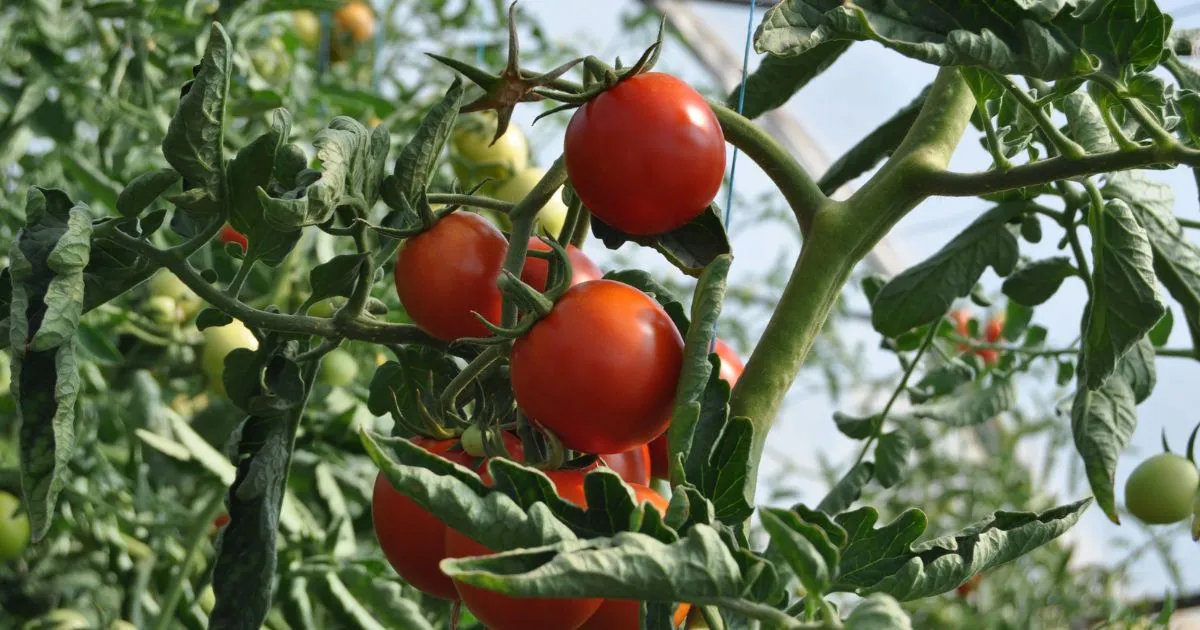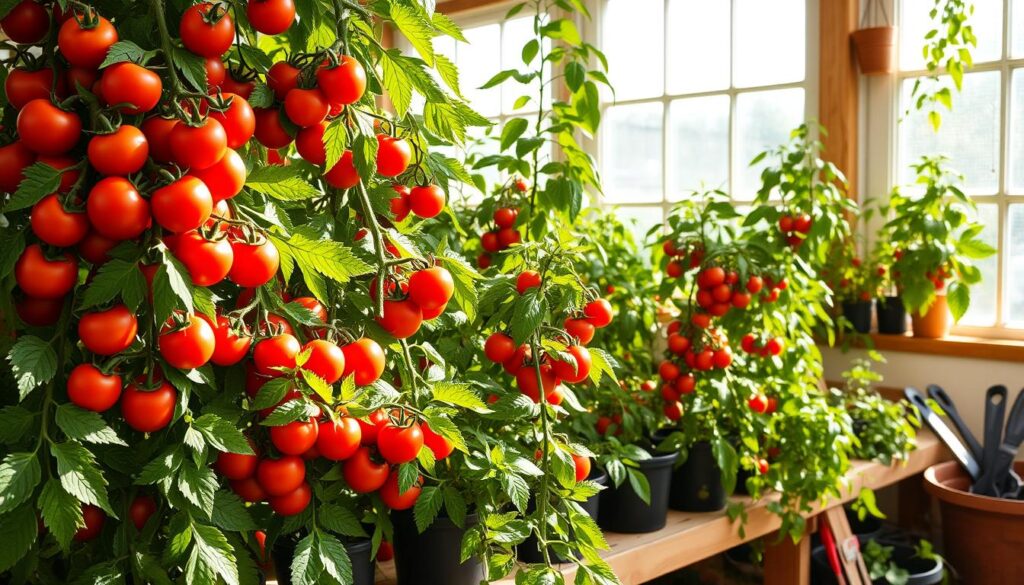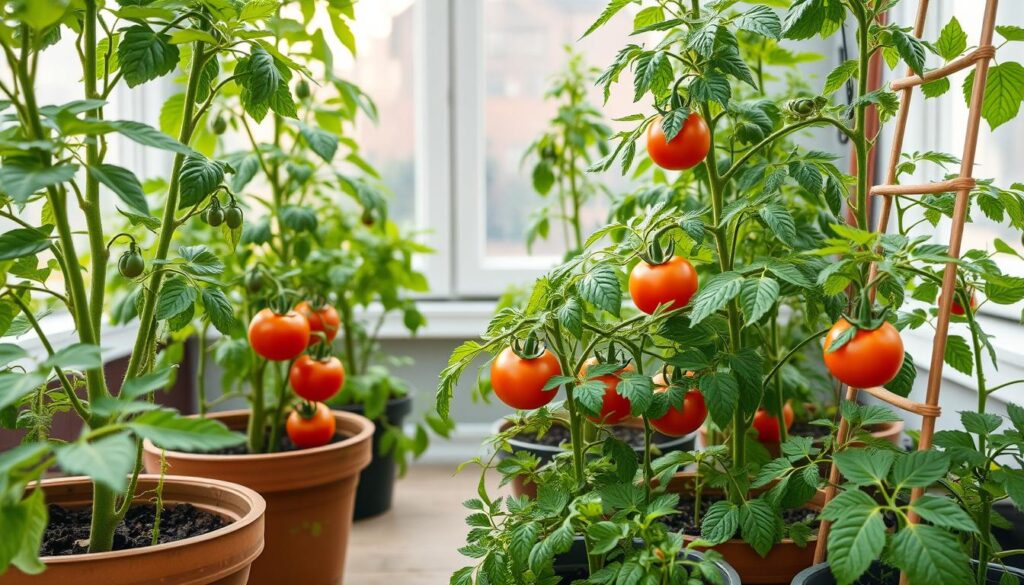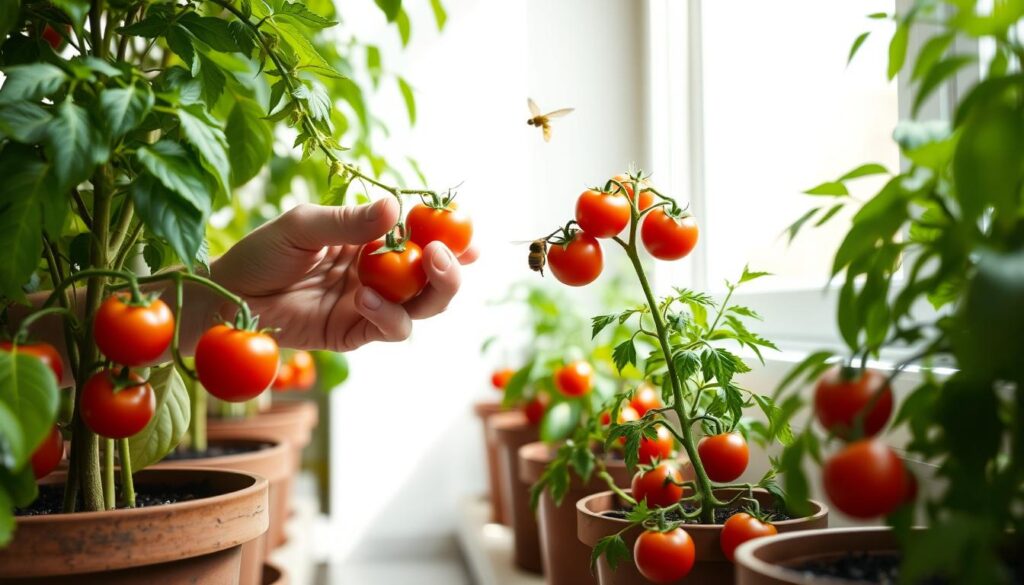Blog
Growing Tomatoes Indoors: Your Step-by-Step Guide 2024

Starting an indoor tomato garden can be very rewarding. It’s great for those with little outdoor space or who love fresh tomatoes all year. This guide will teach you everything you need to know to grow delicious tomatoes indoors.

Table of Contents
Essential Requirements for Growing Tomatoes Indoors
To grow indoor tomato plants well, you need to know the best conditions. This includes the right temperature, humidity, light, and container size. By setting up the perfect space, your tomato plant care will flourish, leading to a great harvest.
Optimal Temperature and Humidity Levels
Tomato plants love a warm, steady temperature. They do best between 70-85°F (21-29°C) during the day and 60-70°F (15-21°C) at night. Keeping this temperature helps them grow and produce fruit well. They also need a humidity of 50-70% to avoid problems like blossom-end rot or fungal diseases.
Best Lighting Conditions for Indoor Tomatoes
Tomato plants need lots of sunlight, at least 6-8 hours a day. If sunlight is scarce, use a good grow light close to the plant. This ensures they get enough light for growth and fruiting.
Space and Container Requirements
- Choose a container that is at least 12 inches (30 cm) deep and wide to accommodate the plant’s root system and provide ample growing space.
- Ensure the container has proper drainage holes to prevent waterlogging and promote healthy root development.
- Allow for approximately 2-3 square feet (0.2-0.3 square meters) of floor space per plant to ensure adequate air circulation and prevent crowding.
| Parameter | Optimal Range |
|---|---|
| Temperature | 70-85°F (21-29°C) day, 60-70°F (15-21°C) night |
| Humidity | 50-70% |
| Lighting | Minimum 6-8 hours of direct sunlight or supplemental grow lights |
| Container Size | At least 12 inches (30 cm) deep and wide |
| Floor Space | 2-3 square feet (0.2-0.3 square meters) per plant |
By meeting these key needs, you can create the best indoor spot for your tomato plant care. This will lead to a healthy, productive indoor tomato harvest.
Selecting the Right Tomato Varieties for Indoor Growing
Choosing the right tomato variety is key for indoor growing. The right variety can make a big difference in your success. Let’s look at what to consider when picking the best tomatoes for your indoor space.
First, think about the plant’s growth habit. Determinate tomatoes, or “bush” tomatoes, are compact and great for containers. They grow to a set size and then focus on making fruit. This makes them perfect for small indoor spaces.
Indeterminate tomatoes, on the other hand, keep growing and making fruit all season. They need more space and care to manage their growth. For smaller spaces, look for compact or dwarf varieties. They’re made for growing in containers.
| Tomato Variety | Growth Habit | Recommended for Indoor Growing |
|---|---|---|
| Cherry Tomatoes | Indeterminate | Yes, but may require more training and pruning |
| Dwarf Tomatoes | Determinate | Yes, excellent for container gardening |
| Patio Tomatoes | Determinate | Yes, specifically bred for indoor and container growing |
| Roma Tomatoes | Determinate | Yes, suitable for indoor cultivation |
When picking tomatoes for indoors, think about fruit size, taste, and how long they take to grow. Cherry tomatoes do well indoors and give you lots of small fruits. Larger tomatoes like beefsteak need more space. By picking the right tomatoes, you can have a great harvest of fresh tomatoes.
Creating the Perfect Indoor Soil Mix for Tomatoes
Starting with the right soil is key to growing healthy indoor tomatoes. The soil mix must meet tomato needs for it to thrive. We’ll look at the key parts, pH balance, and drainage to make the best soil for your tomatoes.
Nutrient-Rich Soil Components
Tomatoes need lots of nutrients. Mix high-quality potting soil, compost, and perlite or vermiculite. This blend will give your tomatoes a strong start. Compost adds organic matter and nutrients slowly. Perlite or vermiculite helps with air and water flow.
pH Balance Requirements
Tomatoes do best in slightly acidic soil, with a pH of 6.0 to 6.8. Check your soil’s pH and adjust it with lime or sulfur. The right pH helps your plants take in nutrients well.
Drainage Considerations
Good drainage is vital for indoor tomatoes to avoid root rot. Add perlite, vermiculite, or coarse sand to your mix. This keeps the soil from getting too wet and keeps your tomato roots healthy.
| Soil Component | Purpose | Recommended Ratio |
|---|---|---|
| Potting Soil | Provides a nutrient-rich base | 50% |
| Compost | Adds organic matter and slow-release nutrients | 30% |
| Perlite or Vermiculite | Improves aeration and drainage | 20% |
By focusing on the right soil mix, you’ll give your indoor tomatoes the best start. This mix should be rich in nutrients, have the right pH, and drain well. With these elements, your tomato garden will flourish.
Growing Tomatoes Indoors: Getting Started
Starting an indoor tomato garden is rewarding, letting you enjoy fresh tomatoes all year. It’s easy and fun, whether you’re new to gardening or have experience. Let’s look at the key steps to make your indoor tomato garden flourish.
Seed Starting and Transplanting
It all starts with picking the right seeds and beginning them indoors. Pick varieties that grow well inside, like compact ones. Start seeds 6-8 weeks before you plan to move them outside, in a good seed starting mix.
When the seedlings have their first true leaves, it’s time to move them to bigger pots.
- Choose a big enough pot, like a 5-gallon one, for the plant’s roots.
- Carefully take the seedling out of the tray, being gentle with the roots.
- Put the seedling in the new pot, covering the stem up to the first leaves to help the roots grow.
- Water well and put it in a bright, warm spot to help it settle.
Positioning and Orientation
Where you put your tomato plants is very important. They need at least 6 hours of direct sunlight a day. This could be a south-facing window or under grow lights. Turn the pots often to make sure they get light evenly and grow well.
“The key to successful indoor tomato growing is providing the right environmental conditions and paying attention to the plant’s needs throughout its lifecycle.”
By starting with these steps, you’re on your way to a great indoor tomato garden. Next, we’ll talk about what your plants need to grow well.
Watering and Fertilization Schedule
Proper watering and fertilization are key for your indoor tomato plants. Knowing their water and nutrient needs helps your plants thrive. This knowledge is vital for a successful indoor tomato garden.
Water Requirements Through Growth Stages
Tomato plants need different amounts of water at each stage. Seedlings and young plants need steady moisture but avoid too much water. As they grow and start producing fruit, they need more water to support this growth.
Watch for signs of too little or too much water. Wilting leaves or yellowing foliage mean you need to adjust your watering. This keeps your plants healthy and strong.
Fertilizer Types and Application
- Choose a balanced, water-soluble fertilizer made for tomatoes or vegetables.
- Fertilize every two to three weeks, following the instructions on the label.
- Use a calcium-rich fertilizer or supplements to prevent blossom end rot in tomatoes.
- Don’t over-fertilize, as it can harm fruit production.
Signs of Over and Under Watering
| Symptom | Cause | Solution |
|---|---|---|
| Wilting leaves | Under-watering | Water the plant thoroughly, but avoid overwatering. |
| Yellowing leaves | Over-watering | Reduce watering frequency and ensure proper drainage. |
| Stunted growth | Under or over-watering | Adjust watering schedule to maintain consistent moisture levels. |
By watching your indoor tomato plants closely, you can give them the best care. This ensures a good harvest. The secret to tomato plant care is finding the right balance between water and nutrients.
Pruning and Training Your Indoor Tomato Plants
Learning how to prune your indoor tomato plants is key to their success. Pruning helps with air flow, boosts fruit production, and keeps plants small in tight spaces.
Why Prune Indoor Tomato Plants?
Pruning your indoor tomato plants has many benefits:
- It improves air flow, reducing disease and pests
- It helps the plant focus on growing bigger, better fruit
- It keeps the plant’s size and shape in check, making it easier to manage indoors
When to Prune Tomato Plants
The best time to prune your indoor tomato plants is when they’re young. Prune them every 2-3 weeks. This helps shape the plant and removes suckers that take energy away from fruit.
| Pruning Stage | Goals |
|---|---|
| Early Growth | Remove suckers and maintain a single, strong main stem |
| Flowering/Fruiting | Prune off lower leaves and remove any unhealthy or damaged foliage |
| Mature Plant | Maintain plant size and shape, remove any diseased or crowded growth |
By using these tomato pruning techniques, your indoor tomato plants will grow strong and productive. They’ll thrive in their indoor home.

“Proper pruning is essential for maximizing indoor tomato yields and maintaining a healthy, well-structured plant.”
Common Pests and Diseases: Prevention and Treatment
Growing tomatoes indoors has its challenges, like pests and diseases. To keep your plants healthy, it’s key to spot and manage these problems early. We’ll look at common pests and diseases, and how to prevent and treat them.
Identifying Common Indoor Tomato Pests
Aphids, spider mites, thrips, and whiteflies are common pests. They can harm your plants, causing them to grow poorly or even die. It’s important to check your plants often and deal with any infestations quickly.
Natural Disease Prevention Methods
Preventing diseases is crucial. Keep your plants in the right conditions, like the right temperature and air flow. Also, choose tomatoes that are less likely to get sick and keep things clean.
Treatment Solutions and Options
If pests or diseases show up, there are natural ways to fight them. For pests, try insecticidal soap or neem oil. For diseases, use baking soda or copper-based solutions, or essential oils like lavender or thyme. Always follow the product instructions.
By being careful and quick to act, you can grow healthy tomatoes indoors. With the right steps, you’ll enjoy a great harvest of fresh tomatoes.
Pollination Techniques for Indoor Tomatoes
Growing tomatoes indoors can be rewarding but comes with challenges. Without outdoor pollinators, indoor plants may not produce fruit. Luckily, there are ways to help your indoor tomatoes thrive.
Hand Pollination: A Reliable Approach
Hand pollination is a simple method. Just gently shake or tap the flowers to move pollen. You can also use a small brush or cotton swab for this task.
Electric Pollinators: A High-Tech Solution
For a more modern solution, electric pollinators are great. They mimic bee vibrations to spread pollen. These devices are easy to use and can be very helpful for indoor growers.
Creating Optimal Conditions for Natural Pollination
Hand pollination and electric pollinators work well. But, creating a good environment for natural pollination is also key. Make sure your plants have good air flow and the right temperature and humidity.
By using these techniques, you can boost your chances of a successful harvest. Enjoy the fresh, tasty tomatoes you grow indoors.

Harvesting and Storing Your Indoor Tomatoes
Knowing when to pick your indoor tomatoes is key. It ensures you enjoy their full flavor and keeps them fresh. Let’s look at the important steps for a successful indoor tomato garden.
Determining Ripeness
The best time to pick your tomatoes is when they’re deep in color and slightly soft. A gentle squeeze will tell you if they’re ready. Don’t pick tomatoes that are still hard, as they won’t taste as good.
Storage Methods and Duration
After picking, you can keep your tomatoes fresh for a while. For a short time, keep them at room temperature, away from sunlight. This lets them ripen and taste better. For longer storage, put them in the fridge. They’ll stay fresh for up to a week there.
By following these steps, you can enjoy your indoor tomatoes for weeks. They’ll add fresh, homegrown taste to all your favorite dishes.
FAQ
What are the optimal temperature and humidity levels for growing tomatoes indoors?
Tomatoes grow best in temperatures between 70-85°F during the day. At night, they prefer 60-70°F. The ideal humidity is 50-70%.
What are the best lighting conditions for growing tomatoes indoors?
Tomatoes need at least 6-8 hours of direct sunlight daily. If sunlight is scarce, use LED or fluorescent grow lights. Place them 12-18 inches above the plants.
What size container should I use for indoor tomato plants?
Choose a container with a minimum of 5 gallons for best growth. Containers of 10-15 gallons are even better. They give more room for the roots to grow.
What are the best tomato varieties for indoor growing?
‘Tiny Tim’, ‘Patio’, and ‘Cherry Cascade’ are great for indoor growing. They are compact and grow well in containers.
How do I create the perfect soil mix for indoor tomatoes?
Mix high-quality potting soil, compost, and perlite or vermiculite for the best soil. Keep the pH between 6.0 and 6.8 for nutrient availability.
When should I start my indoor tomato plants?
Start seeds 6-8 weeks before the last frost date. This lets the seedlings develop a strong root system before transplanting.
How often should I water and fertilize my indoor tomato plants?
Water when the top 1-2 inches of soil are dry. Don’t overwater. Fertilize every 2-3 weeks with a balanced, water-soluble fertilizer.
How do I prune and train my indoor tomato plants?
Prune regularly to remove suckers and keep a single stem. Train the plant to a trellis or cage for better air and fruit production.
What are common pests and diseases that can affect indoor tomato plants?
Watch out for aphids, spider mites, and whiteflies. Fungal diseases like early blight and powdery mildew can also occur. Use organic treatments to prevent and treat these issues.
How do I pollinate my indoor tomato plants?
Indoor tomatoes may need manual pollination. Use a small paintbrush or electric pollinator to transfer pollen from anthers to stigmas.
How do I know when to harvest my indoor tomato crop?
Tomatoes are ready when they’re fully colored and slightly soft. Gently twist and pull them from the vine, being careful not to damage the plant.
Read more Growing Potatoes in Bags